Properties and opioid inhibition of mesolimbic dopamine neurons vary according to target location
- PMID: 16525058
- PMCID: PMC3623681
- DOI: 10.1523/JNEUROSCI.4331-05.2006
Properties and opioid inhibition of mesolimbic dopamine neurons vary according to target location
Abstract
The mesolimbic dopamine system, which mediates the rewarding properties of nearly all drugs of abuse, originates in the ventral tegmental area (VTA) and sends major projections to both the nucleus accumbens (NAc) and the basolateral amygdala (BLA). To address whether differences occur between neurons that project to these separate areas, retrograde microspheres were injected to either the BLA or the NAc of DBA/2J mice. Whole-cell recordings were made from labeled VTA dopamine neurons. We found that identified neurons that projected to the BLA and NAc originated within different quadrants of the VTA with neither group exhibiting large-amplitude h-currents. Neurons that projected to the NAc exhibited a greater outward current in response to the kappa-opioid agonist (5alpha,7alpha,8alpha)-(+)-N-methyl-N-[7-(pyrrolidinyl)-1-oxaspiro [4,5]dec-8-yl]-benzeneacetamide (U69593; 200 nM), whereas neurons that projected to the BLA exhibited greater inhibition to the mu/delta opioid agonist [Met5] enkephalin (ME; 3 microM). In addition, we found that the presynaptic inhibition of GABAergic transmission at both GABAA and GABAB receptors was differentially regulated by U69593 between the two groups. When dopamine IPSCs were examined, U69593 caused a greater inhibition in NAc- than BLA-projecting neurons. ME had no effect on either. Finally, the regulation of extracellular dopamine by dopamine uptake transporters was equal across the VTA. These results suggest that opioids differentially inhibit mesolimbic neurons depending on their target projections. Identifying the properties of projecting mesolimbic VTA dopamine neurons is crucial to understanding the action of drugs of abuse.
Figures
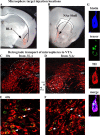


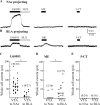
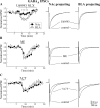
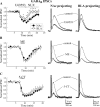
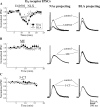

References
-
- Adell A, Artigas F (2004). The somatodendritic release of dopamine in the ventral tegmental area and its regulation by afferent transmitter systems. Neurosci Biobehav Rev 28:415–431. - PubMed
-
- Albanese A, Minciacchi D (1983). Organization of the ascending projections from the ventral tegmental area: a multiple fluorescent retrograde tracer study in the rat. J Comp Neurol 216:406–420. - PubMed
-
- Bachtell RK, Whisler K, Karanian D, Self DW (2005). Effects of intranucleus accumbens shell administration of dopamine agonists and antagonists on cocaine-taking and cocaine-seeking behaviors in the rat. Psychopharmacology (Berl) 183:41–53. - PubMed
-
- Bals-Kubik R, Ableitner A, Herz A, Shippenberg TS (1993). Neuroanatomical sites mediating the motivational effects of opioids as mapped by the conditioned place preference paradigm in rats. J Pharmacol Exp Ther 264:489–495. - PubMed
-
- Beckstead MJ, Grandy DK, Wickman K, Williams JT (2004). Vesicular dopamine release elicits an inhibitory postsynaptic current in midbrain dopamine neurons. Neuron 42:939–946. - PubMed
Publication types
MeSH terms
Substances
Associated data
- Actions
Grants and funding
LinkOut - more resources
Full Text Sources
Research Materials
